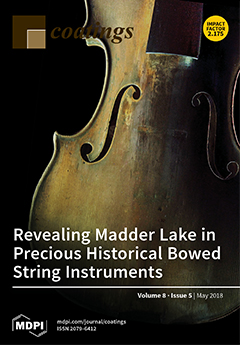High-Si-content transition metal nitride coatings, which exhibited an X-ray amorphous phase, were proposed as protective coatings on glass molding dies. In a previous study, the Zr–Si–N coatings with Si contents of 24–30 at.% exhibited the hardness of Si
3N
4, which
[...] Read more.
High-Si-content transition metal nitride coatings, which exhibited an X-ray amorphous phase, were proposed as protective coatings on glass molding dies. In a previous study, the Zr–Si–N coatings with Si contents of 24–30 at.% exhibited the hardness of Si
3N
4, which was higher than those of the middle-Si-content (19 at.%) coatings. In this study, the bonding characteristics of the constituent elements of Zr–Si–N coatings were evaluated through X-ray photoelectron spectroscopy. Results indicated that the Zr 3d
5/2 levels were 179.14–180.22 and 180.75–181.61 eV for the Zr–N bonds in ZrN and Zr
3N
4 compounds, respectively. Moreover, the percentage of Zr–N bond in the Zr
3N
4 compound increased with increasing Si content in the Zr–Si–N coatings. The Zr–N bond of Zr
3N
4 dominated when the Si content was >24 at.%. Therefore, high Si content can stabilize the Zr–N compound in the M
3N
4 bonding structure. Furthermore, the thermal stability and chemical inertness of Zr–Si–N coatings were evaluated by conducting thermal cycle annealing at 270 °C and 600 °C in a 15-ppm O
2–N
2 atmosphere. The results indicated that a Zr
22Si
29N
49/Ti/WC assembly was suitable as a protective coating against SiO
2–B
2O
3–BaO-based glass for 450 thermal cycles.
Full article





